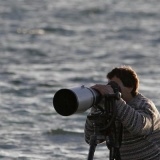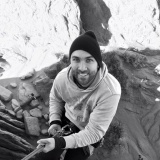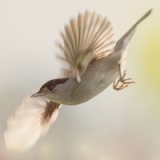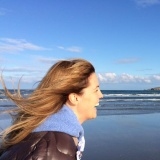- Forum
- Photography and Camera Forum
- Photo Galleries - For General Display or Critique
- Nature and all Wildlife
- Practicing For Warbler and Songbird Photography
Practicing For Warbler and Songbird Photography
-
 Topic Author
Topic Author
- Paul-Rossi
- Vendor
-
- Canon EOS 1D Mark 2
- Followers: 176
- Posts: 333
-
Points:
9184
Post #577334
Honing your hand-to-eye coordination with respect to this type of photography pays off. Note that the center focusing point is used because it has the fastest ability to automatically adjust focus.
-

- Sara Miles
- Master of the Lens
- Followers: 196
- Posts: 1526
-
Points:
22954
-

- Kyle Johnson
- The Lounger
- Followers: 176
- Posts: 1484
-
Points:
21932
Post #577472
-
 Topic Author
Topic Author
- Paul-Rossi
- Vendor
-
- Canon EOS 1D Mark 2
- Followers: 176
- Posts: 333
-
Points:
9184
Post #577519
-

- garyrhook
- Oh Wise One
-
- Nikon D850, Nikon D750, Panasonic G7K
- Followers: 912
- Posts: 11103
-
Points:
67681
-

- G Vernon
- Apprentice
-
- Nikon D500 / Nikon D810 / Nikon 105mm macro / Nikon 24-70mm / Nikon 200-500mm
- Followers: 200
- Posts: 2450
-
Points:
24691
Post #577983
-

- Hannah Williams
- Master of the Lens
- Followers: 188
- Posts: 1505
-
Points:
22078
-
 Topic Author
Topic Author
- Paul-Rossi
- Vendor
-
- Canon EOS 1D Mark 2
- Followers: 176
- Posts: 333
-
Points:
9184
Post #578956
-
 Topic Author
Topic Author
- Paul-Rossi
- Vendor
-
- Canon EOS 1D Mark 2
- Followers: 176
- Posts: 333
-
Points:
9184
Post #579451
-

- garyrhook
- Oh Wise One
-
- Nikon D850, Nikon D750, Panasonic G7K
- Followers: 912
- Posts: 11103
-
Points:
67681
Post #579458
Paul-Rossi wrote: I am replying to this because I won't let people think that what you implying - that I do not know what I am doing - stand.
I'm implying no such thing.
There's more than one way to skin a cat, and if you're going to discuss technique, I think it's worthwhile to mention alternatives (back-button focus) as well as support assertions that, on the surface, seem... "odd". Especially when it's the first I've ever heard of it.
Your Canon product may suffer from performance degradation when using non-center focus points. I will assert that my Nikon product does not (based on admittedly less experience, but a hundred thousand shots, give or take). So I'm simply suggesting that claiming that one thing is better, without specificity and basis, might be misleading. Thoroughness and clarity are Good Things, don't you think? Which you added here. Thank you for that. Very useful and interesting information.
Now I want to contact Nikon to inquire about this performance question.
-

- Steve Rodriguez
- The Lounger
- Followers: 150
- Posts: 1478
-
Points:
21581
-

- G Vernon
- Apprentice
-
- Nikon D500 / Nikon D810 / Nikon 105mm macro / Nikon 24-70mm / Nikon 200-500mm
- Followers: 200
- Posts: 2450
-
Points:
24691
Post #579761
With respect the back button focus technique will maintain absolute focus on small warblers actively flitting about on branches because AF-C is selected. The focus will only lock on the subject when you take your finger off the AF-ON back button allowing you to recompose if needed - something that is impossible with the shutter button configured to AF-C. With the D5 / D500 and the D850 you can also designate the joystick to act as a secondary back button giving you the option of having single point AF-C on the main back button plus an additional 25 points or more configured to the joystick. A good example would be using the single focus point on the eye of a bird, if the bird suddenly takes flight you can at the touch of a button switch to a larger number of AF points for better coverage. Some people are infinitely more comfortable using the BB technique because of this advantage conversely some are happy to remain with the shutter button alone. I think it´s important when presenting workshops that knowledge of different techniques with differing camera systems can be demonstrated.. I captured all my flying dragonflies with the BBF technique on AF-C and they are very small and lightning fast..
-
 Topic Author
Topic Author
- Paul-Rossi
- Vendor
-
- Canon EOS 1D Mark 2
- Followers: 176
- Posts: 333
-
Points:
9184
Post #579776
-

- Rohan Tushar
- The Lounger
- Followers: 159
- Posts: 1419
-
Points:
21366
-

- Adam Wilson
- The Lounger
- Followers: 148
- Posts: 1433
-
Points:
20700
- Forum
- Photography and Camera Forum
- Photo Galleries - For General Display or Critique
- Nature and all Wildlife
- Practicing For Warbler and Songbird Photography
Latest Reviews
The Canon EOS R100 is an entry-level mirrorless camera introduced in 2023. But just because it’s an entry-level camera doesn’t mean it’s a bare-bones camera. Find out why in this review!
Nikon’s retro-looking Nikon Zfc is anything but retro. Under its classic body is a host of features and amenities that make it a worthwhile compact mirrorless camera for 2024.
The Canon EOS R50 is one of the newest R-system cameras from Canon. Is it worth your money? Find out all the details you need to know in this comprehensive review.
The Sony FE 70-200mm f/2.8 GM OSS II is Sony’s flagship mirrorless zoom lens. As such, it’s loaded with features and has a top-shelf build quality that makes it a top pick!
Forum Top Posters
-
1Pitter 2 posts
-
2EOS Man 2 posts
-
3Shadowfixe... 2 posts
-
4Stephen Graham 1 post
-
5Ziggy 1 post
-
6Joshua Atkins 1 post
-
7SJM 1 post
-
8Scotty 1 post
Latest Articles
Creating impactful photos of landscapes depends on many factors, not the least of which is your talent behind the lens. This guide explores other elements required for the best product.
The Canon EOS R100 is an entry-level mirrorless camera introduced in 2023. But just because it’s an entry-level camera doesn’t mean it’s a bare-bones camera. Find out why in this review!
Are you ready to upgrade your camera? Before buying new, you might consider the value of purchasing used gear to save money.
The Olympus OM-D E-M10 Mark IV is a micro four thirds camera released in 2020. It’s an entry-level system along with the OM-D E-M5 Mark III. Use this guide to determine which one is best for you!
Blue hour photography might not be as well known as golden hour photography, but it is every bit as good a time to create epic images of landscapes. Learn how in this quick tutorial!
Nikon’s retro-looking Nikon Zfc is anything but retro. Under its classic body is a host of features and amenities that make it a worthwhile compact mirrorless camera for 2024.
Moving from taking snapshots of your dog to creating beautiful images doesn’t have to be that difficult! Use the tips outlined in this dog photography guide, and you’ll get better results in no time.
Acrylic print photos are a beautiful way to display your favorite images. But they don’t come without some questions. Get all the answers you need about this medium in this guide!















